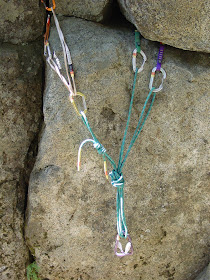One way to eliminate some of the fear and to build a more secure anchor is to build anchors "In Series."
In the past we've discussed SRENE and ERNEST anchors. The standard is that these anchors are built off of three or four pieces with a cordellete as in the following picture.
 A Standard Pre-Equalized SRENE Anchor
A Standard Pre-Equalized SRENE AnchorThe angles on this particular anchor are a bit wide between each of the outside pieces.
In an ideal three piece anchor all of the pieces are completely solid. In an ideal anchor each of the pieces can hold a tremendous amount of weight by themselves. In an ideal anchor, the powerpoint can easily hold ten times the weight of the two climbers on the route.
But what if it can't?
When the pieces aren't solid, you have to add more. To keep it simple, the best way to add more pieces is to add them in series. This is a method wherein one SRENE anchor is stacked on top of another SRENE Anchor. This system allows a climber to do a couple of things. First it allows one to add more pieces to the anchor. Second, it allows those pieces to be added in a simplistic way that makes sense with a cordellette or an extra sling. And third, it spreads out the weight at the powerpoint into more equalized pieces.
 An Anchor In Series with a Magic X on the Left-Hand Leg
An Anchor In Series with a Magic X on the Left-Hand LegWhile the preceding picture may seem to tell the whole story, there is one thing to consider when building an anchor in series. One element that is terribly important to be aware of is that if a magic x (self-equalizing twist) is used in the system, it may not be as effective as a pre-equalized knot in the system.
In the picture above, the left hand leg of the cordellette terminates in a sling clipped to two pieces and equalized with a magic x. The problem with a magic x in this kind of system is that if one of those left hand pieces blows out, the sling will become limp and the weight will not automatically transfer to the other piece in the magic x. If this happens, then all of the weight will be placed on the two pieces on the right.
It's better to build two pre-equalized anchors on top of each other when working in series. However, occasionally this isn't possible and you're forced to work with a magic x. When that happens, make sure that the pieces that are not a part of the x are extremely strong.
In the picture above, the left hand leg of the cordellette terminates in a sling clipped to two pieces and equalized with a magic x. The problem with a magic x in this kind of system is that if one of those left hand pieces blows out, the sling will become limp and the weight will not automatically transfer to the other piece in the magic x. If this happens, then all of the weight will be placed on the two pieces on the right.
It's better to build two pre-equalized anchors on top of each other when working in series. However, occasionally this isn't possible and you're forced to work with a magic x. When that happens, make sure that the pieces that are not a part of the x are extremely strong.
 An Anchor In Series with a Pre-Equalized Knot on the Right-Hand Leg
An Anchor In Series with a Pre-Equalized Knot on the Right-Hand LegThis anchor is essentially a three piece anchor that was linked together in series
because the climber only had two double-shoulder length runners to build an anchor.
It is quite possible to build a vast anchor with codellettes and slings in series. And sometimes -- when the rock is very bad -- that is exactly what you have to do.
--Jason D. Martin
No comments:
Post a Comment
Thank you for your comment. An administrator will post your comment after he/she moderates it.